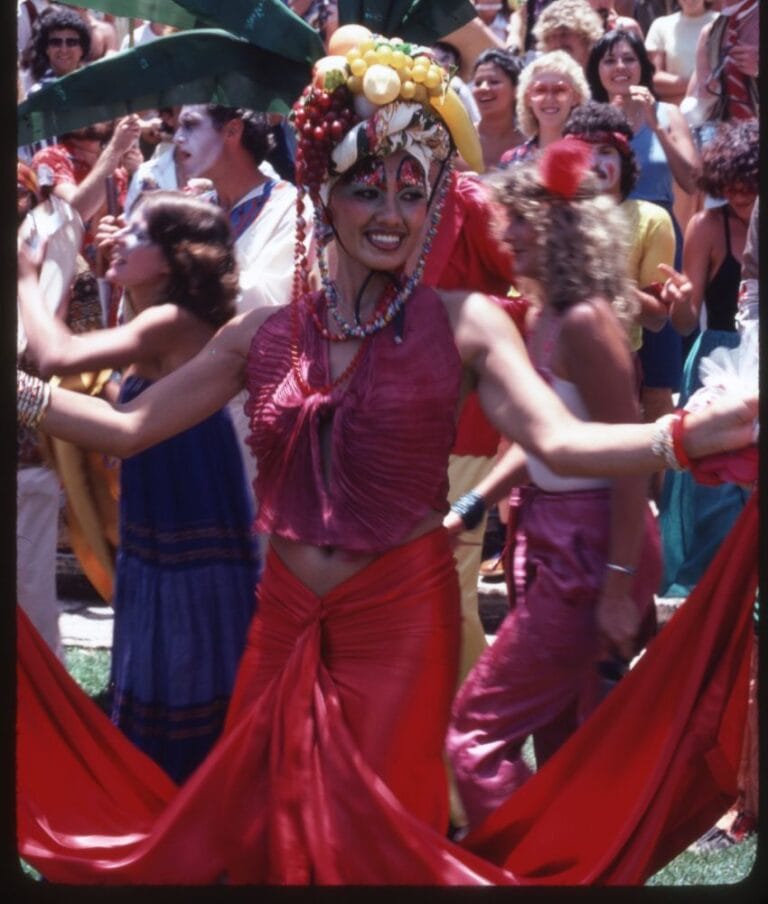Every promotional poster heralding Santa Barbara’s unique Summer Solstice Celebration for the past 50 years and hundreds of photographs documenting its early years are among the many items in a new exhibit “Here Comes the Sun: Celebrating 50 Years of Santa Barbara Summer Solstice” on view at the Santa Barbara Historical Museum through June 27.
In just 50 years, a small caravan of artists and mimes organized by Michael Gonzales has grown to a three-day extravaganza of street performance, dance, “people-powered” floats, and live music. The Summer Solstice Parade now features more than 1,000 participants and is watched by thousands more.
Many parade creations were burned in bonfires in the early days as part of the celebration, making these items even more precious,” says Dacia Harwood, the museum’s director. “We are lucky that they survived and now can be enjoyed by our community during this special anniversary.”
In addition to the poster and photo displays, the exhibit features a 9-foot-tall wearable “walking puppet” and several puppet heads and masks on loan from the Summer Solstice Celebration, along with items from the Museum’s collection of colorful handmade banners and masks. Two paintings by the event’s founder Michael Gonzales are on loan from the Santa Barbara County Office of Arts & Culture. Oral histories of event organizers and longtime participants can be accessed via QR codes.
This year’s parade is Saturday, June 22, and the associated festival in Alameda Park is Friday through Sunday, June 21-23. For more information, visit www.solsticeparade.com.
All 50 Solstice Posters and More
The Museum holds a complete collection of official Solstice posters, which are a mix of works by well-known professional and talented amateur artists, and were chosen by competition each year. Arranged chronologically, some are signed by the artists. An interactive digital portal allows visitors to read about each poster and artist.
Two original paintings by Solstice founder Michael Gonzales are on view. Each was showcased in the annual posters, one in 1981 (the last year he directed the parade) and another in 1982. He died in 1989 at age 38. Both are on loan from the Santa Barbara County Office of Arts & Culture.
Hundreds of Photographs from Late 1970s Through 1980s
In the museum’s large Sala, the focus is on the celebration’s expansion from its inception in 1974 with hundreds of historic images of the artists working in preparation, the parade itself, and associated celebrations. A 2018 video about Solstice by Justin Gunn, current president of the Summer Solstice Celebration, is also running on a loop.
The largest collection of images was contributed by photographer Nell Campbell who began photographing Summer Solstice in 1977. Campbell came to Santa Barbara in 1969 to attend the Brooks Institute of Photography, and became a visual documentarian, especially known for her images of civic protests.
Nell came in with her light table and slides of these amazing images,” says Emily Alessio, the Museum’s Education & Visitor Experience Manager. “She is a master of finding just the perfect person in a huge group. Her images and those from the Solstice’s collection are exactly what the Museum is committed to preserving and making available to the public.”
Giant Puppet, Masks, and Oral Histories
A staple of the Solstice Parade are gigantic 9-foot-tall puppets topped by elaborate painted heads that are worn and operated by their artist creators. An example from the early 2000s by artist Anne Chevrefils shows the backpack and sticks used to operate the “walking puppet.” Several individual puppet heads by Chevrefils are also on view.
Two exquisite masks adorned by seashells from the Museum’s collection were created by Dave McKay and Greg Schultz and worn in an ocean-themed dance ensemble in the 1988 parade.
Segments from oral histories recorded by early Summer Solstice organizers and artists can be accessed by guests via QR codes. The interviews were recorded in 2023 as part of Solstice’s Legacy Project as a way to preserve the voices of Summer Solstice participants throughout the celebration’s 50-year history.


Leave a Response